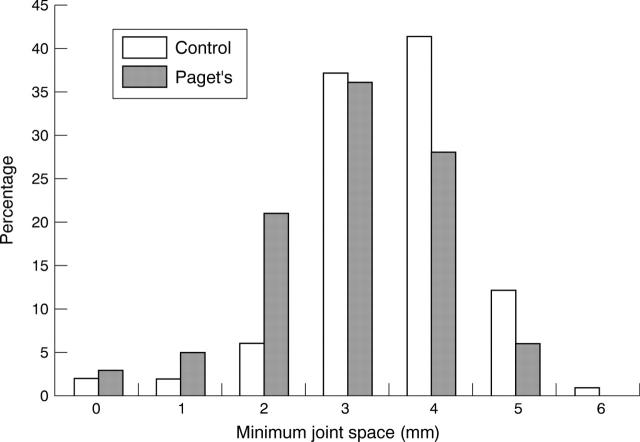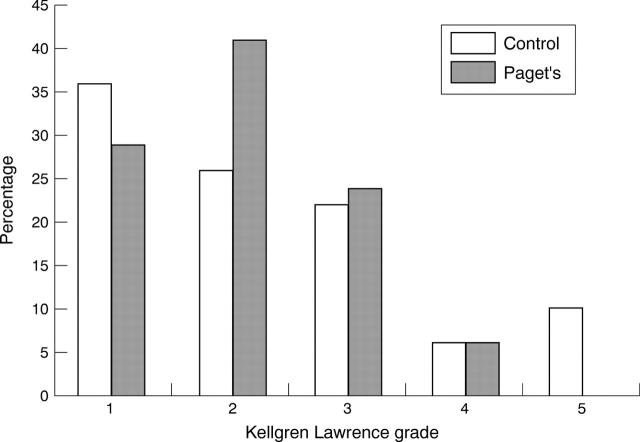Abstract
BACKGROUND—Paget's disease of bone is common and often undiagnosed in the population. The association of Paget's disease and osteoarthritis is well described but only in cases ascertained in secondary and tertiary care centres to which they have been referred largely because of pain. This study represents an attempt to confirm the association between Paget's disease and osteoarthritis in a population previously unknown to have Paget's disease. METHODS—Radiographs of people over 55 years that included the entire pelvis, sacrum, femoral heads and lumbar spine (mostly plain abdominal radiographs) were obtained from hospital records for the period 1993-95. Films were screened by a trained observer and the positive films were reviewed by a consultant radiologist who also examined a 1 in 10 sample of the negative films. A sub-sample of 153 confirmed positive cases were matched for age and sex using cases without Paget's disease and these pairs were assessed by two observers working in tandem. The hip joints were scored 0-5 using a modification of the original descriptive classification of Kellgren and Lawrence and minimum joint space of the hip was also measured. RESULTS—Not all cases were available for assessment. A total of 248 films were included (137 without Paget's, 89 with unilateral and 22 with bilateral disease). The mean age of the cases and controls was 78.4 years and 77.4 years respectively with 66/45 male/female cases and 78/59 male/female controls. One hundred and twenty nine affected hips were available for comparison with 352 unaffected hips. Median joint space narrowing for the affected hip was 3 mm (range, 0-5 mm) and for the unaffected hip 4 mm (range, 0-6 mm, Mann-Whitney U test, p=0.00001). Median Kellgren and Lawrence grade for both groups was 0, with no statistical difference between the groups (Mann-Whitney U test, p=0.74). In terms of severity of osteoarthritis, there were 19 instances of grades 2+ in the unaffected hips, and only five in the affected hips. CONCLUSIONS—Pagetic coxopathy is characterised by loss of joint space, which may represent a secondary chondropathy. Although joint failure may result from this secondary chondropathy progression may be dependent on non-Pagetic factors. It is also possible that the usual radiological features of osteoarthritis may be modified or obscured by the Paget's disease.
Full Text
The Full Text of this article is available as a PDF (62.0 KB).
Figure 1 .
Histogram of minimum joint space for Pagetic and control joints.
Figure 2 .
Histogram of Kellgren and Lawrence scores for Pagetic and control joints. Note joints scoring grade 0 (Pagetic, n = 112; control, n = 304) have been omitted.
Selected References
These references are in PubMed. This may not be the complete list of references from this article.
- Cooper C., Schafheutle K., Dennison E., Kellingray S., Guyer P., Barker D. The epidemiology of Paget's disease in Britain: is the prevalence decreasing? J Bone Miner Res. 1999 Feb;14(2):192–197. doi: 10.1359/jbmr.1999.14.2.192. [DOI] [PubMed] [Google Scholar]
- Croft P., Cooper C., Wickham C., Coggon D. Defining osteoarthritis of the hip for epidemiologic studies. Am J Epidemiol. 1990 Sep;132(3):514–522. doi: 10.1093/oxfordjournals.aje.a115687. [DOI] [PubMed] [Google Scholar]
- Graham J., Harris W. H. Paget's disease involving the hip joint. J Bone Joint Surg Br. 1971 Nov;53(4):650–659. [PubMed] [Google Scholar]
- Guyer P. B., Dewbury K. C. The hip joint in Paget's disease (Paget's "coxopathy"). Br J Radiol. 1978 Aug;51(608):574–578. doi: 10.1259/0007-1285-51-608-574. [DOI] [PubMed] [Google Scholar]
- Hadjipavlou A., Lander P., Srolovitz H. Pagetic arthritis. Pathophysiology and management. Clin Orthop Relat Res. 1986 Jul;(208):15–19. [PubMed] [Google Scholar]
- Helliwell P. S. Osteoarthritis and Paget's disease. Br J Rheumatol. 1995 Nov;34(11):1061–1063. doi: 10.1093/rheumatology/34.11.1061. [DOI] [PubMed] [Google Scholar]




